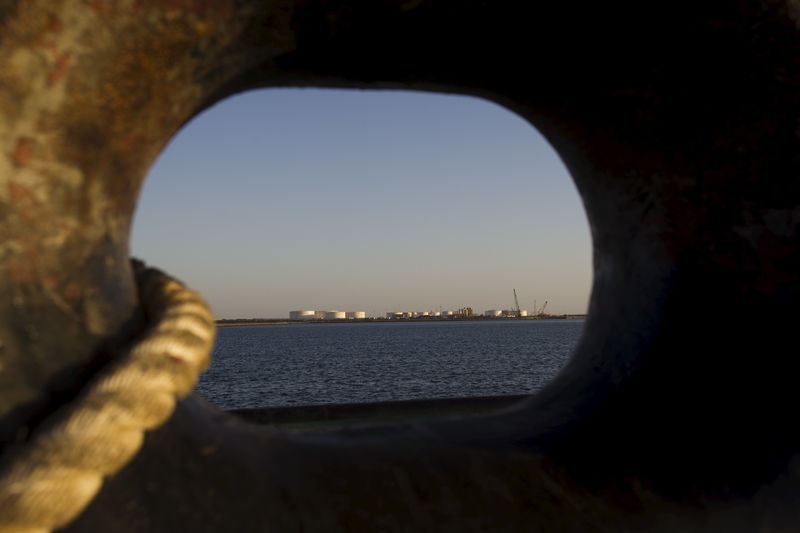* Wildfires have cut oil sand production by 1.5 million bpd
* Most of Canadian oil sand crude exported to U.S. by
pipeline
* Middle East, Latin American tanker imports to compensate
* But high U.S. crude inventories to act as cap to imports
By Keith Wallis
SINGAPORE, May 10 (Reuters) - Canada's wildfires, which have
knocked out some 1.5 million barrels of daily oil production,
are expected to drive up tanker imports and freight rates as
U.S. consumers seek alternative supplies after a drop in
Canadian pipeline supplies.
With most Canadian oil sand crude piped to the United
States, importers there will need bigger seaborne imports,
mostly into the Gulf of Mexico, adding to existing port
congestion.
Although crude stored in North America could be used to
overcome some of the disruption, shipping experts expect tanker
imports and freight rates to rise.
"To compensate for the shortfall, the U.S. needs to either
ramp up other imports, which would be seaborne, or draw down on
inventories. The first alternative would be good for tankers
now, whilst the second alternative is positive in the longer
term," said Trygve Munthe, co-chief executive of Norwegian-based
tanker owner DHT Management DHT.N .
Average rates this year for a Very Large Crude Carrier
(VLCC) carrying 2 million barrels of oil are around $56,000 per
day, according to shipping services firm Clarkson CKN.L , while
average rates for a smaller Suexmax, carrying around 1 million
barrels, are around $36,000 per day.
This increased demand, equivalent to around 36 VLCCs if the
outage lasted 12 months, according to Norway's Arctic
Securities, could offset the negative impact on freight rates
from new tanker deliveries.
Around 56 VLCCs are scheduled for delivery this year.
LATAM AND MIDEAST TO STEP IN
Latin American and Middle East producers are seen as the
most likely to supply substitute oil.
With Venezuela facing stalled production, Ralph Leszczynski
of ship broker Banchero Costa said that Colombia and Ecuador
were likely substitutes for Canadian crude as they produce
similar heavy grades.
If, however, Canada's outages persist, shippers said that
Middle East suppliers would be the only ones with enough spare
capacity to step in.
"If this drags out over time, we think the Middle East is
the only producing region with an ability to ramp up production
on a more sustained basis," Munthe said.
For the time being, North American storage could meet some
of the lost production, and Canada's oil sands facilities have
been left largely undamaged.
"Restarting shuttered production will take several weeks
after fires are extinguished, even with no damage," Morgan
Stanley said in a note to clients.
U.S. commercial crude stockpiles have likely risen for five
straight weeks to a record of over 543 million barrels, traders
said.
MAP-Gulf of Mexico oil tanker congestion reuters://REALTIME/verb=Interactive%20Map/context=%3CNavigation%3E%3CEntities%3E%3CEntity%3E%3CInteractiveMap%20version=%221%22%3E%3CMap%3E%3CMapTargetZoom%3E7%3C/MapTargetZoom%3E%3CMapTargetCenter%20X=%22-92.36008453%22%20Y=%2228.81308964%22%20/%3E%3CMapMode%3E2%3C/MapMode%3E%3CWrapAround%3ETrue%3C/WrapAround%3E%3CLayers%3E%3CLayer%20Type=%22TankerVessels%22%3E%3CConfiguration%3E%3CVesselTypeRoot%3E%3CItem%20RCS=%22F:3H%22%3E%3CItem%20RCS=%22F:3I%22%20Selected=%22False%22%20/%3E%3CItem%20RCS=%22F:3J%22%20Selected=%22False%22%20/%3E%3CItem%20RCS=%22F:3K%22%20Selected=%22False%22%20/%3E%3CItem%20RCS=%22F:3N%22%3E%3CItem%20RCS=%22F:3P%22%20Selected=%22False%22%20/%3E%3C/Item%3E%3CItem%20RCS=%22F:3Y%22%20Selected=%22False%22%20/%3E%3C/Item%3E%3C/VesselTypeRoot%3E%3C/Configuration%3E%3C/Layer%3E%3C/Layers%3E%3C/Map%3E%3C/InteractiveMap%3E%3C/Entity%3E%3C/Entities%3E%3C/Navigation%3E
^^^^^^^^^^^^^^^^^^^^^^^^^^^^^^^^^^^^^^^^^^^^^^^^^^^^^^^^^^^>
(Editing by Henning Gloystein and Ed Davies)
